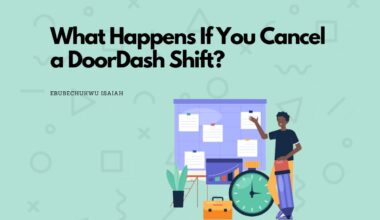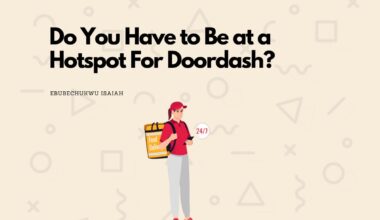Upcharges are quite common in most industries that help or simplify businesses for other industries. Commonly called B2B.
Take a minute to think about companies that position themselves as resource, catalysts, or mediators to get services around you that could be once difficult to get easily.
They all cost extra money to run.
And if we’re to be honest, DoorDash and the food delivery company at large fall into this set of industries.
But is DoorDash an exception? I’d be upfront with you; it’s a no. They’re not.
Now, let’s take a proper look at this…
Does DoorDash Upcharge Food?
Yes, in many ways DoorDash upcharges food.
These are the “many ways” DoorDash upcharges food…
Increase in Menu Price
Starting with the obvious, the menu price.
If you’re conversant with buying food traditionally from restaurants you might notice some discrepancies between the menu prices of DoorDash and these restaurants.
No, that was not a sudden price hike.
Surprisingly, DoorDash is not behind this directly. They don’t inflate the prices restaurants set.
Rather, just like most delivery companies, DoorDash charges restaurants a percentage of every delivery as their service fee.
So it’s up to the restaurants to know how they can recover the cost of using DoorDash.
Most merchants recover this by increasing the price of items on the menu, corresponding to the charge from DoorDash.
Editors note: Keep in mind increase in menu price is not applicable to all restaurants.
This way they run their business with delivery companies effortlessly.
Secondary Charges
After the menu prices you find, you’d expect to pay for the delivery fees and checkout, right?
Of course, DoorDash’s work is to just help you do the delivery, nothing more.
Well, unfortunately, that’s not what happens.
You see, the delivery fee is only one part of the fees you need to pay for a delivery service on DoorDash.
We covered the list of hidden fees extensively in a previous article, but for the sake of the article we’d take a quick overview.
Firstly, DoorDash claims the delivery charge is the fee that goes specifically into what it takes to deliver.
A part of this fee goes to the driver (as a driver myself, this is almost never more than $3.), while another part into their secondary services (such as the ability to issue refund, delivery infrastructure maintenance, etc).
According to DoorDash, the delivery fee heavily depends on the distance between the restaurant and your location, and the demand for drivers at the time of your order.
So what are the other fees we made mention of?
- Service Fee: DoorDash applies a service fee to every order to cover operational costs. DoorDash claims this is the fee that helps the platform to maintain its service, improve the app, and provide customer support. The service fee is usually a percentage of the total bill and is separate from the delivery fee.
- Small Order Fee: To make each delivery worth the effort for drivers, DoorDash charges a small order fee for orders that fall below a certain total cost which is anonymous to the public.
- Taxes: Like with any other purchase, taxes are applied to DoorDash orders based on local tax laws. This includes both sales tax and any other applicable local taxes which will be added to the total cost of your order.
- Busy Fee: During peak hours or at times when there’s a high demand for deliveries, DoorDash may charge a busy fee. This fee is dynamic and aims to incentivize more drivers to be available during busy times, helping to ensure that customers can still get their food delivered promptly.
- Tips: While not a fee per se, DoorDash provides an option for customers to tip their drivers either at the time of placing the order or after the delivery has been made. Tips are a significant part of a driver’s earnings, and it’s a way for customers to show appreciation for the service. But if I’m to be honest, it’s actually more than an appreciation.
All these are obviously enough to be called a fully-fledged upcharge.
How to get more for less price on DoorDash
1. Compare Prices
If getting food at a way lower price means a lot to you, then you want to always compare between different restaurants.
You want to begin by comparing prices. Prices can vary significantly between different restaurants on DoorDash.
You could just choose a few restaurants you want to check and do the maths yourself.
This is doable if you’re a person to ride or die with a particular restaurant.
Now, other factors like the distance of the restaurants can play a huge impact on the amount of charges a delivery incurs.
The farther the restaurants, the higher the hidden fees.
Editor tip: some restaurants may have special deals or discounts available which can provide further savings
Lastly, this shouldn’t just be only limited to DoorDash.
In the past, we’ve seen a huge margin between the prices of orders across food delivery companies.
But then, there’s no hard fact as to what company offers cheaper food generally. It varies by location.
In other words, it’s important to know what works for you.
2. Use Promo Codes and Coupons
You can almost always get a coupon or promo code every time you try to.
DoorDash does send them periodically, new users have them being offered, and a thorough search on the internet could land you one.
Getting one of these codes per order is a good way to get discounts on the total order amount, free delivery, or a specific dollar amount of the order.
3. Join Dashpass
DashPass is a subscription service by DoorDash that cuts off the delivery fee charge for all deliveries throughout the month a user subscribes.
In other words, by subscribing to Dashpass you get free delivery on orders from eligible restaurants. That’s a good amount of money that could be potentially saved.
However, this can only be particularly cost-effective if you use DoorDash frequently.
Here, the savings on delivery and service fees over time can more than cover the cost of the DashPass subscription.
Otherwise, you may need to rethink.
4. Order During Off-Peak Hours
DoorDash may charge a busy fee during peak hours when demand for delivery is high.
Ordering during off-peak hours can help avoid this additional fee.
Off-peak hours are typically in the mid-morning or late afternoon, although this can vary depending on the day and the specific area.
Not only can ordering during off-peak hours save money, but it may also result in faster delivery times as drivers are more readily available and traffic may be lighter.
As an Amazon Associate, I earn a small commission from qualifying purchases. Learn more about this.






